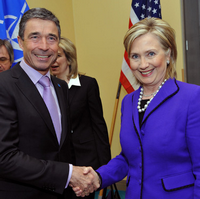At a recent NATO foreign ministers meeting in Tallinn, U.S. Secretary of State Hillary Clinton said that the United States would not withdraw its tactical nuclear weapons (TNWs) from Europe in the near-term future. Clinton also said that these weapons should only be drawn down if done so simultaneously with similar Russian systems. NATO Secretary-General Anders Fogh Rasmussen echoed these sentiments and stated that U.S. nuclear weapons in Europe are an integral part of the alliance's deterrent. But in addition to being increasingly unpopular among U.S. allies, the estimated 150-200 U.S. TNWs in Europe (.pdf) also lack military utility and deterrent value, for a number of reasons.
The vast majority of foreign policy analysts view a potential Russian invasion of Europe as an anachronistic Cold War nightmare. Still, Article 5 of the North Atlantic Treaty carries significant deterrent weight, because it represents a U.S. pledge to defend its NATO allies in the event of an attack. There is a certain level of redundancy to U.S. TNW deployments, since the United States has already committed itself to European security with its conventional and strategic nuclear forces. Additionally, there are legitimate questions regarding the ability of these weapons to serve their intended military purpose -- as a force multiplier to aid alliance troops on the battlefield.
The U.S. nuclear weapons in Europe are all B61 gravity bombs, with yield selections ranging from 0.3 to 170 kilotons. In comparison, "Little Boy," the atomic bomb that destroyed Hiroshima, had an estimated yield of 15 kilotons. Bombs with payloads in the B61's upper range would present a grave threat to NATO forces in the field and are simply not usable. However, even weapons with sub-kiloton yields could risk exposing alliance soldiers to high levels of radiation, as well as eye injuries from the ultraviolet, infrared, and visible light rays released by the bombs.

